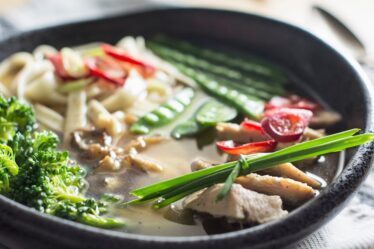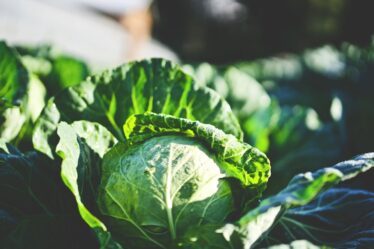
Ramen’s history in the United States dates back to the late 19th century when Japanese immigrants began arriving. However, its popularity surged after World War II. In the 1950s, Momofuku Ando, founder of Nissin Foods, introduced instant ramen noodles to the American market.
This affordable and convenient meal quickly became popular among college students and households nationwide. During the 1980s and 1990s, as interest in international cuisine grew, ramen shops began appearing in major cities like Los Angeles, San Francisco, and New York. Initially catering to Japanese expatriates, these shops soon attracted a broader American audience as culinary tastes expanded.
Today, ramen is a widely enjoyed comfort food in the United States, with various regional styles and flavors available. Its evolution from instant noodles to gourmet ramen shops has solidified its place in American culinary culture. Ramen continues to adapt to suit American tastes while maintaining its status as a beloved dish across the country.
Key Takeaways
- Ramen first gained popularity in the United States after World War II when Japanese immigrants brought the dish to the country.
- Authentic ramen can be identified by its rich and flavorful broth, chewy and springy noodles, and carefully crafted toppings such as chashu pork and marinated soft-boiled eggs.
- California is home to some of the best ramen spots in the country, with popular locations in cities like Los Angeles, San Francisco, and San Diego.
- New York City boasts a wide variety of delicious ramen options, with many top-rated restaurants located in neighborhoods like East Village and Midtown Manhattan.
- Lesser-known states also have hidden gems when it comes to ramen, with standout restaurants in places like Oregon, Texas, and Colorado.
- Ramen trends across the country include unique flavors and ingredients such as truffle oil, spicy miso, and fusion combinations like ramen burgers and ramen tacos.
- Making your own ramen at home can be a fun and rewarding experience, with tips including using high-quality ingredients, experimenting with different broths and toppings, and perfecting the art of noodle-making.
How to Identify Authentic Ramen
Authentic ramen is a complex and deeply satisfying dish that is much more than just a simple bowl of noodles. To identify authentic ramen, there are several key components to look for. First and foremost, the broth is a crucial element of any good bowl of ramen.
Traditional ramen broths are typically made from pork bones (tonkotsu), chicken (shoyu), or seafood (shio), and are simmered for hours or even days to develop rich, complex flavors. Another important aspect of authentic ramen is the noodles themselves. Ramen noodles should have a firm, chewy texture and should be made from wheat flour, water, salt, and an alkaline mineral water called kansui.
The shape and thickness of the noodles can vary depending on the regional style of ramen being served. In addition to the broth and noodles, authentic ramen should also be topped with a variety of garnishes such as chashu (braised pork belly), menma (fermented bamboo shoots), nori (seaweed), and a perfectly cooked soft-boiled egg. These toppings add layers of flavor and texture to the dish, elevating it from a simple bowl of noodles to a truly satisfying meal.
The Best Ramen Spots in California

California is home to a vibrant and diverse ramen scene, with countless restaurants serving up delicious bowls of this beloved comfort food. In Los Angeles, one standout ramen spot is Tsujita LA Artisan Noodle, known for its rich and flavorful tonkotsu broth and perfectly chewy noodles. Another must-visit ramen shop in LA is Daikokuya, which offers a variety of ramen styles including tonkotsu, shoyu, and miso.
San Francisco is another hot spot for ramen lovers, with popular restaurants like Mensho Tokyo and Hinodeya Ramen Bar serving up top-notch bowls of this comforting dish. Mensho Tokyo is known for its innovative approach to ramen, with unique flavor combinations and high-quality ingredients. Hinodeya Ramen Bar, on the other hand, specializes in traditional shoyu and shio ramen made with locally sourced, organic ingredients.
In San Diego, Tajima Ramen is a local favorite, offering a wide range of ramen styles including tonkotsu, shoyu, and spicy miso. With multiple locations across the city, Tajima Ramen has become a go-to spot for authentic and delicious ramen in Southern California.
Where to Find the Most Delicious Ramen in New York
| Restaurant Name | Location | Rating |
|---|---|---|
| Ippudo | East Village | 4.5 |
| Totto Ramen | Hell’s Kitchen | 4.3 |
| Jin Ramen | Harlem | 4.2 |
| Ramen Lab | Nolita | 4.4 |
New York City is home to some of the best ramen restaurants in the country, with a wide range of styles and flavors to choose from. One standout spot is Ippudo NY, which has gained a cult following for its rich and creamy tonkotsu broth and perfectly cooked noodles. Another popular ramen destination in NYC is Totto Ramen, known for its flavorful chicken-based broth and tender slices of char siu pork.
For those looking for a more unique ramen experience, Mu Ramen in Long Island City offers creative and innovative takes on this classic dish. With options like oxtail mazemen and foie gras tsukemen on the menu, Mu Ramen pushes the boundaries of traditional ramen while still delivering on flavor and quality. In Brooklyn, Chuko Ramen is a local favorite, serving up delicious bowls of both traditional and inventive ramen dishes.
From classic tonkotsu to vegetarian miso ramen, Chuko has something for everyone and has earned a reputation for its consistently high-quality food.
Hidden Gems: The Top Ramen Restaurants in Lesser-Known States
While California and New York may be known for their thriving ramen scenes, there are plenty of hidden gems across the country serving up delicious bowls of this beloved comfort food. In Portland, Oregon, Afuri Ramen + Dumpling is a standout destination for authentic and flavorful ramen. With a focus on using high-quality ingredients and traditional cooking techniques, Afuri has quickly become a local favorite.
In Austin, Texas, Ramen Tatsu-Ya has gained a loyal following for its rich and satisfying bowls of tonkotsu and mazemen. The restaurant’s commitment to using locally sourced ingredients and making everything from scratch sets it apart from other ramen spots in the area. In Minneapolis, Minnesota, Zen Box Izakaya offers a unique take on traditional Japanese cuisine, including an impressive selection of ramen dishes.
With options like miso butter corn ramen and spicy tan tan men, Zen Box Izakaya brings bold flavors and creative twists to this classic comfort food.
Ramen Trends: Unique Flavors and Ingredients Across the Country

As ramen continues to gain popularity in the United States, chefs and restaurateurs are experimenting with unique flavors and ingredients to put their own spin on this classic dish. One popular trend is the use of non-traditional broths such as vegan or vegetarian options made with ingredients like mushrooms or seaweed. These alternative broths offer a lighter yet still flavorful alternative to traditional pork or chicken-based broths.
Another trend in the world of ramen is the incorporation of unexpected ingredients like truffle oil, foie gras, or even fried chicken as toppings. These unconventional additions add an element of luxury and indulgence to an otherwise humble dish, appealing to adventurous eaters looking for something new and exciting. In addition to new flavors and ingredients, regional variations of ramen are also gaining traction across the country.
From spicy miso ramen in the Midwest to seafood-based broths on the East Coast, chefs are drawing inspiration from their surroundings to create unique and regionally specific styles of ramen.
Tips for Making Your Own Ramen at Home
For those who want to try their hand at making authentic ramen at home, there are a few key tips to keep in mind. First and foremost, take the time to make a flavorful broth by simmering pork bones or chicken carcasses with aromatics like garlic, ginger, and scallions for several hours. This slow cooking process allows the flavors to develop and intensify, resulting in a rich and satisfying broth.
When it comes to noodles, look for fresh or dried ramen noodles made with wheat flour and kansui (alkaline mineral water). Cook the noodles according to the package instructions and be sure not to overcook them, as they should have a firm yet chewy texture. Finally, don’t skimp on the toppings!
Traditional ramen toppings like chashu pork, soft-boiled eggs, nori, and menma add depth and complexity to the dish. Get creative with your toppings and don’t be afraid to experiment with different flavor combinations. In conclusion, ramen has become an integral part of American culinary culture, with a rich history and diverse array of styles and flavors available across the country.
Whether you’re looking for traditional tonkotsu or innovative fusion dishes, there’s no shortage of delicious ramen options to explore in every corner of the United States. And for those who want to try their hand at making their own homemade ramen, following these tips can help you create a satisfying bowl of this beloved comfort food in your own kitchen.
If you’re a ramen lover, you’ll definitely want to check out this article on the best ramen in every state. From classic tonkotsu to spicy miso, this list has got you covered. And if you’re looking to pair your ramen with a refreshing drink, be sure to read about the potent benefits of boldo in this article.
FAQs
What is the best ramen in every state article about?
The article highlights the best ramen restaurants in each state across the United States.
How were the best ramen restaurants in each state chosen?
The best ramen restaurants in each state were chosen based on a combination of factors including customer reviews, expert opinions, and overall popularity.
Are the restaurants listed in the article ranked in any particular order?
The restaurants listed in the article are not ranked in any particular order. Each restaurant is simply recognized as the best ramen spot in its respective state.
Does the article include information about different types of ramen available at each restaurant?
Yes, the article provides information about the different types of ramen available at each restaurant, including traditional flavors and unique variations.
Are there any specific dietary options mentioned in the article?
The article may include information about dietary options such as vegetarian or gluten-free ramen offerings at certain restaurants.
Is the article focused on a specific style of ramen or does it cover a variety of styles?
The article covers a variety of ramen styles, including traditional tonkotsu, shoyu, miso, and other regional variations from across Japan.
Does the article provide information about the ambiance and dining experience at each restaurant?
Yes, the article may include details about the ambiance, dining experience, and overall atmosphere at each of the best ramen restaurants in every state.



